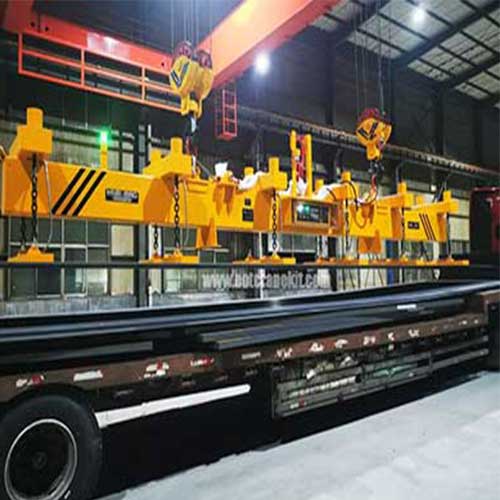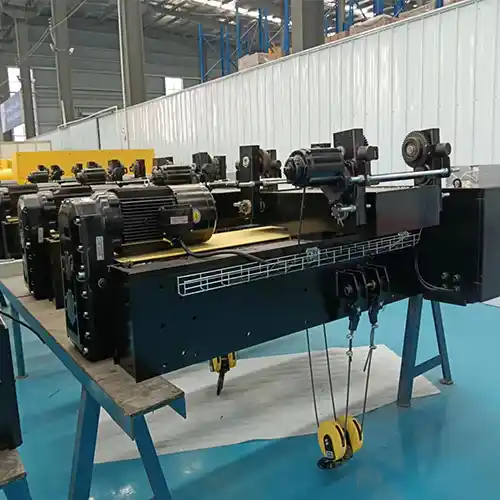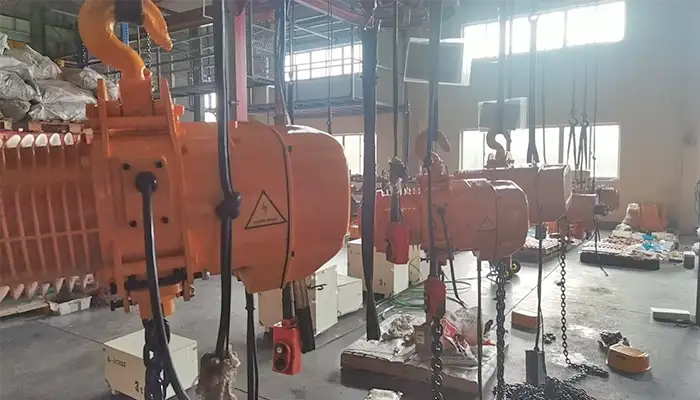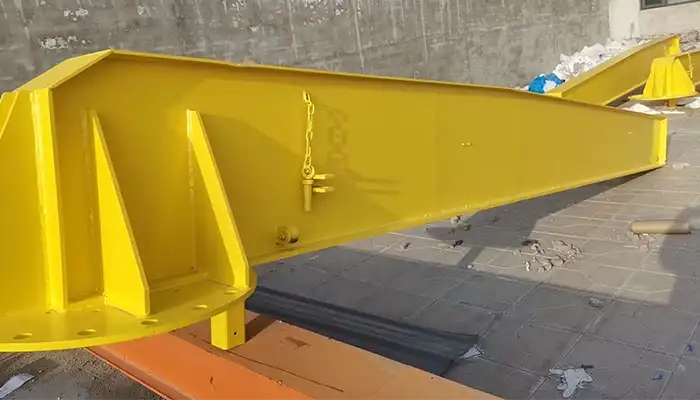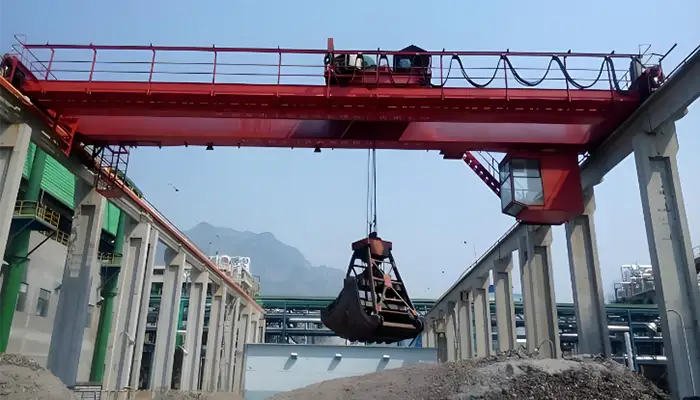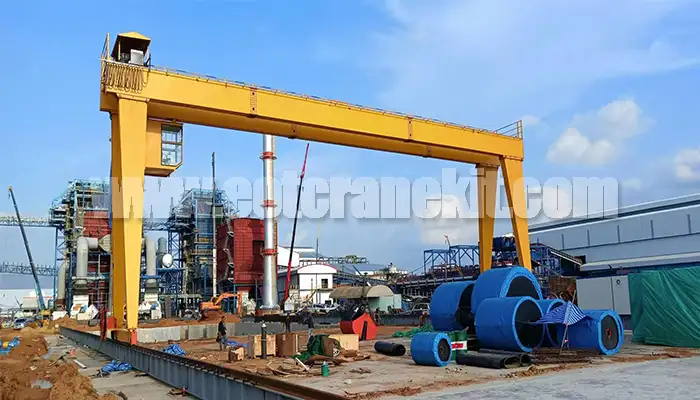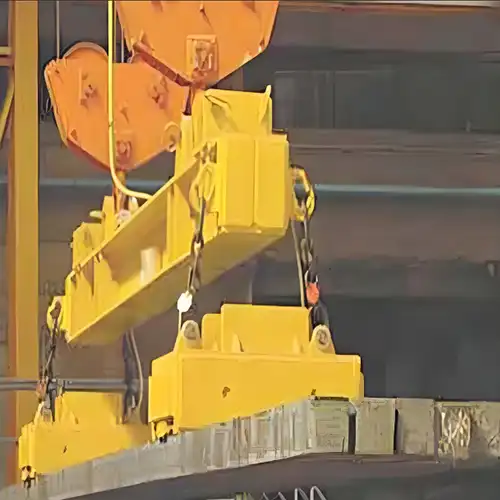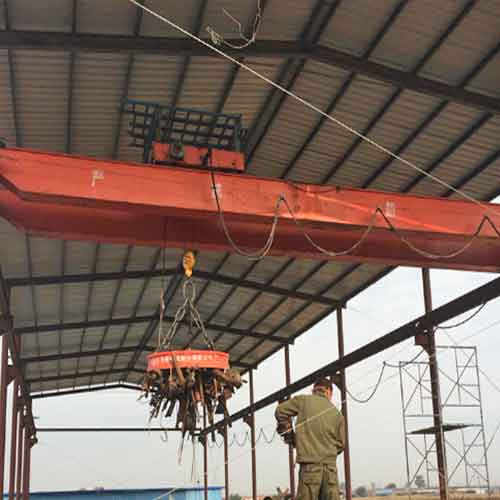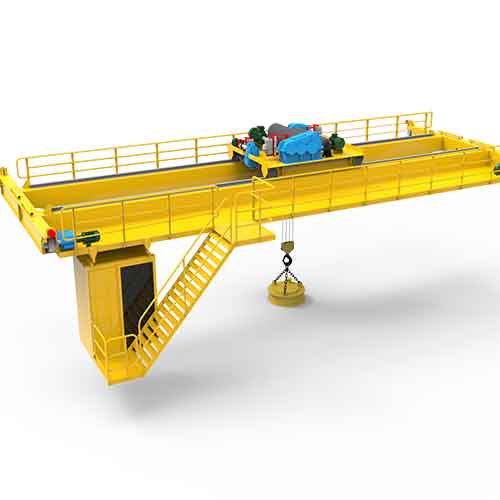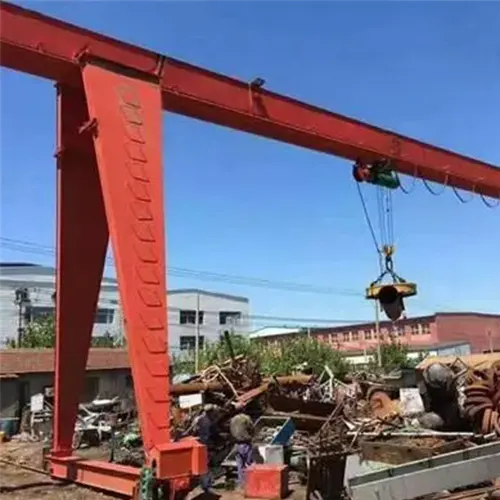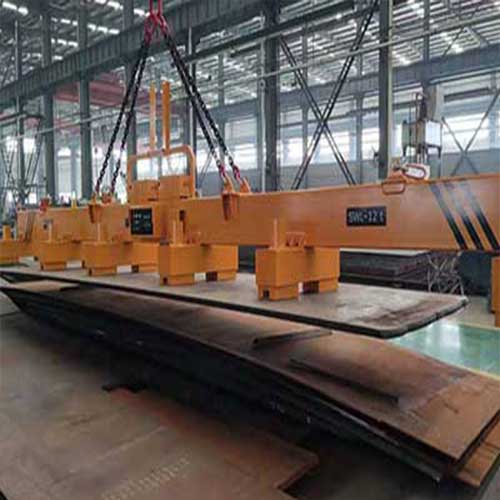Steel Plate Handling Crane, Magnetic Bridge Crane & Gantry Crane
Steel plate handling cranes, custom overhead crane & goliath crane for handling plates of single & multiple layers, long & short, thin & thick, horizontal & vertical,etc.
Category: Magnetic Crane
Your Trusted Overhead Crane Manufacturer & Supplier
Steel Plate Crane with Different Plate Lifters
Custom Bridge Crane & Gantry Crane for handling Plates of Various Sizes & Weights
What is steel plates handling cranes? Steel plates handling cranes is typically a customized overhead crane , overhead goliath cranes, jib cranes for steel plates of different weights and dimensions, with different plates handling devices, such as, plate hook, clamps, wire rope slings, vacuum lifters, and magnetic lifters for various industrial sectors. Electromagnetic overhead cranes & gantry cranes are one of the most frequently used cranes for steel plates handling of all types & sizes, such as for handling single & multiple plates, long & short, thin & thick, horizontal & vertical plates, etc. They are supposed to improve your steel plates handling safety and efficiency.

Overhead crane for indoor plate handling
The overhead plate handling cranes with top running and underhung crane design can be used in indoor or outdoor steel plates handling with capacity is from 1 t to 320 ton . According to user requirements, the overhead steel plate crane can be equippted with below hook devices such as, wire rope slings, steel plate clamps, plate hooks, and magnet beam spreader, etc.
- Crane Capacity: 1-320 tons
- Crane Span: ≥10m
- Crane Lifting height: ≥5m
- Crane Work duty: A3-A7
Fully customized plate handling bridge crane solutions are available ahead standard configurations.

Gantry crane for steel plates handling
We offer single girder and double girder gantry crane solutions that are efficient and reliable for handling different types and sizes of steel plates in a variety of settings, including manufacturing assembly lines, railway freight yards, warehouses, logistics hubs, power plants, construction sites, shipyards, and port terminals, etc.
Main specificaitons of gantry crane
- Load capacity: 5-500t
- Span: 18-35m
- Lifting height: 6-18m
- Work duty: A3-A7
Custom gantry cranes can be designed with your tailored specification and can be equipped with different steel plate lifter to meet your particular needs.

The free-standing crane for steel plates handling, also known as the pillar jib crane, is frequently employed for light plates handling both indoors and outside. In comparison to wall mounted jib cranes, pillar jib cranes offer higher capacity, longer spans, and more rotations.
- Jib capacity: 0.5-10t,
- Jib lift height: 3-12m,
- Working class: A3.
For steel plate handling, the pillar jib crane is usually equipped with vacuum lifter for thin & lighter steel sheet handling .
Different types of steel plate lifters for plate handling cranes
Steel plate handling cranes are used to handle various types of steel plates of various types of sizes including long and narrow plate, thin & thick plate, vertical plat & horizontal plate, single plate & layers of steel plates handling. Plate handling cranes are often designed using a gantry crane or bridge crane with a double girder or double beam design for both inside and outdoor material handling use. Different steel plate lifters are chosen for various applications.
In the following the main types of steel plates handling lifter are presented for your reference. If you want to know more please click to check our sheet lifter and plate lifters. If you need a customized steel plate lifter with tailors specifications or for special applications, please feel free to contact us by leaving a message down below or by whats-app 0086 151 3871 1597.
The following are the main types of steel plate lifters:
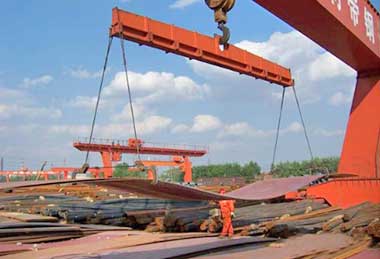
Slings and ropes: the very first way of handling steelplates, which has been proven to be incredibly time-consuming and extremely ineffective. In particular, liftingmetal sheets with slings poses a significant safety risk to the worker or people on the job site because the heavy plate may slip and inflict injury. As a result, the bulk of steel makers have abandoned it.
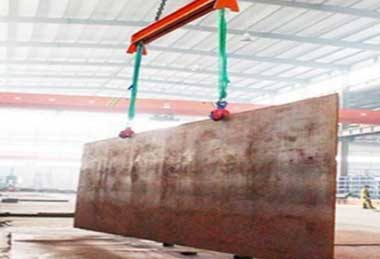
Steel plate lifting clamps: Plate clamps are designed to liftplates with specific thickness which has been limitedby the manufacturer's design specifications markedon the clamp. They must never be used to clampplates that are thinner or thicker than the thickness specified on the plate clamp identification tag. Due to the clamping design, the possibility of sheet or plate damage or scratchesis unavoidable.
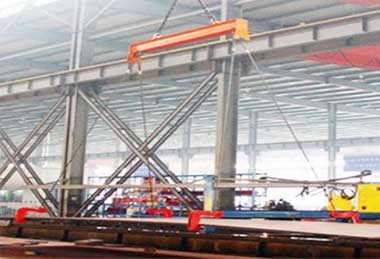
Plate hooks: Lifting hooks are available witha variety of shapes and sizes, Steel plate hooks,like plate clamps, has the potential to harm the plate.

Lifting magnets: A types of advanced and safe steel and iron handling devices, which can be used for various types of metal objects handling and espcially for large, long and heavy steel plates, pipe, profile beams, etc.
What is the best way to lift a steel plate or sheet metal? Plate lifting magnets are the first and final solution for large steel industries that need to lift or move massive mounts and sizes ofsteel plates on a regular basis. Plate magnets for lifting steelsare a win-win solution for small firms that emphasize lifting safety and handling efficiency.
What makes them go for our magnetic overhead cranes and gantry cranes for steel plate?
- Wide appliations. Provide versatile lifting solutions for 8-150mm plates, as well as selectable control of magnet lifters for lifting plates of varying lengths, thinkness, and weights.
- High effectiveness. When hanging medium-thick plates, the magnetizing and demagnetizing times are under 3 seconds, and the magnetization is transferred directly to the plate, making it extremely effective.
- High precision. Precise lifting of a single plate without picking up the second sheet, ensuring that the plates are stacked in serial order (each plate is labeled with a unique number), as the steelplates must be loaded in order to be cut.
- No damage to steel plates. Magnetic handling craneswill ensure your plates safety and causeno damage to the plate surface and ensure the productivity of the whole production line.
- High safety. The remote control enable the worker to operate it safely, and at same time it lower labor cost since only one operator is required. If there is a sudden power outage, the lifted steelplateswon't fall because the magnetic lifting force remains for a certain period of time.
- Cost-effective. One person may independently operate the steel plate electro permanent lifting magnet, saving labor costs.
Other advantages of using an electromagnetic cranelifter for steel plate handlinginclude faster handling speed with lower handling costs, better utilization of storage places by expanding available space, and so on. That is how we help companies and factoriessuch as steel plates andsheetsmanufacturers and distributors by bringing performance and safety to their workplace.
Your Trusted Overhead Crane Manufacturer & Supplier
Focusing on Safety & Efficiency
Safe Lifting Steel Plates in different Industrial Sectors
Overhead crane & gantry crane with electromagnet for different sizes & weights of steel plates handling
Lifting short or long, thin or thick plates has always been a difficult problem for steel mills or steel structures where plates must be moved and handled on a daily basis. Overhead cranes and gantry cranes for steel plate with electromagnetic lifting beam can help improve handling efficiency and ensure human safety. With electromagnetic steel plate handling cranes, manufacturers no longer have to worry about plate dropping during the transfer or moving them inefficiently.
Sheet & Plate handling magnet bridge cranes and gantry cranes are developed as an alternative to unsafe vacuum systems and plate hook and clamping devices. Magnetic lifting crane systems increase the safety of the operations in the steel plate lifting, transportation, storing , loading and unloading, etc.

Bridge crane for vertical or title plate handling

Semi gantry cranes & full gantry cranes with electro-magnetic for indoor and outdoor steel plates handling
Industrial applications of steel plate handling cranes
Steel plates are frequently used in pressure vessels, marine and offshore equipment, structural and building applications, and military applications. The use of a steel plate depends on its grade, composition, and other characteristics.Shipbuilding, construction, machine building, and the production of large-diameter pipes are some of the most important consumer industries.
To meet various steel plate handling requirements and applications, the Steel plate cranes are available with various types and configurations including overhead bridge cranes, gantry cranes and goliath crane, rotating jib cranes, RMG crane & RTG cranes for various industrial sectors and application conditions, such as, metal fabrication, shipbuilding, steel mill, automotive, medical industry, mechanical engineering, transport company, material store, etc.

Steel wholesalers.

Train and rolling stock

Metal cutting workshops

white

Medical

Automation
For meet steel plate handling in various situation in different industrial sectors. The plate handling crane needs to be customized.
What are the types of steel plates can be handled by electromagnetic cranes ?
Steel plate is a metal plate, typically steel plate, that can be cut and made into a more complex product. Steel plates are available in a variety of thicknesses and can be fabricated to any length or width that you require. There are typical sizes available, such as 48"x96" or 96"x120".
Steel plates cranes can be customized with different numbers and sizes of the magnets in the system, which are determined based on the size of plate to be lifted. Plate handling crane with electromagnetic beam can be used to handling
- steel plates and steel sheet of different thickness
- Steel plates of various lengths
- Single plates & multiple layers of steel plates handling
- Vertical & horizonal steel plate handling
Your Trusted Overhead Crane Manufacturer & Supplier
Thin Steel Sheet & Thick Steel Plate Handling
Electromagnetic handling cranes for steel plates of different thickness.
Electromagnetic steel plate cranes can be used for handling of steel plates and sheet with different thickness. We recommend a magnet bridge crane and electromagnetic goliath craneswith adjustable magnetic field strength/ magnetic permeability depth based on plate thickness. This distinct feature enables the operator to adjust the "pre-magnetization" intensity in order to pull a single sheet of plate from the stack. The operator can then execute a "full magnetization" level on the magnet manually or automatically to improve safety.

SLABS
regarded as a partially completed product. used mostly in the manufacturing of coils and plates and in the heavy machinery industry.

STEEL PLATE
Steel plate is a plate of metal, specifically steel, that can be cut and manufactured into a more elaborate product.

SHEETS
Sheets – thin, flat steel pieces. Highly versatile, it can be cut and bent into many different shapes.
Thin sheet & thick plates handling cranes
In general, a sheet is a thinner piece of metal that has been sliced from a continuously rolled coil. As a result, it can be as thin as 1mm or as thick as 25mm. A plate is a thicker piece of metal that has been manufactured (rolled) as a single piece. Thickness might range from 150mm or more to as little as 2mm from some manufacturers. Customized magnetic bridge cranes can handle steel plates of various thicknesses.
The lifting magnets for single steel sheets are often used for stacked steel plates with a thickness of less than 6mm.As the plate thickness reduces ,the number of magnets in the system grows and the magnets become wider.Unlike vacuum systems, magnetic systems may securely lift plates with no surface scratches.
The special custom lifting magnet cranes for thin sheets & thick plates are now applicable to various applicaitons and conditions, such as loading and unloading, cutting lines, and warehouses.

Thin steel plate handling
Magnets for lifting thin steel plates with a minimum thickness of 3 mm are known as thin steel plate lifting magnets. Usually, thin steel plates and sheets are lengthy and have a thin thickness. Because of this, lifting long and thin steel plates or sheets is more difficult and quite risky. The steel plate/sheets with a minimum thickness of 3 mm work perfectly with the thin plate lifting magnets. They are made up of several electro permanent magnet modules that are elastically suspended for ideal steel sheet adaption.

Thick Single Steel Plate Lifting Magnets
Electromagnets with spreader beam for lifting single steel sheet with min. thickness of 5mm . A selection switch installed in the electronic control unit enables the activation or deactivation of a chosen number of magnetic modules. One steel sheet may be lifted during the PICK-UP cycle. Using the standard supplied radio remote control or the integrated digital push buttons, you may control the plate handling operation.
Single heavy steel plates handling
It has been quite difficult to lift a single heavy steel plate. Traditional steel liftersare inefficient and unresponsive to a safety incident. As safety awareness in the workplace continues to rise, more safety managers are looking for new steel lifting equipment to address the aforementioned issues. How can massive steel plates be lifted? You might want to usean electro permanent magnet bridge cranes and goliath cranes.
Three reasons why magnetic overhead cranesfor heavy steel plates:
High efficiency, resulting in time and energy savings.
The application of a standard lifting clamp and platehook demands the use of more than one person at the same time. It is time-consuming and exhausting. While the operation of a lifting magnet is quite simple: it may be operated by one person using a remote control. To effortlessly handleheavy steel plates, it can be operated with a single button.
High reliability and security, eliminating the hidden risk of heavy steel plate dropping.
Companies are improving their lifting equipment to eliminate safety incidents as people grow more safety conscious. Using an electro permanent lifting magnet helps prevent falling steel plates caused by power outages. In the event of a power outage, it retains its magnetism. That is, as long as it is not issued the demagnetization order (which takes only 0.21 second), it can keep the magnetic force indefinitely. Many large corporations and factoryare increasingly requesting electro permanent magnetic lifters to handle ferrous workpieces, primarily because they emphasize their security.
No damage to the surface of the heavy steel plate, does not affect the next process
Heavy steel plate often weighs several tons or tens of tons. Surface scratches are easily caused by the use of a lifting hook or clamp. For some fine processing requirements, scratches may impair process accuracy, increasing the likelihood of faulty output. The multi-point layout design, spring design, or rubber pad design of magnetic steel plate liftershas been shown to reduce surface scratches and ensure process accuracy.
Your Trusted Overhead Crane Manufacturer & Supplier
Narrow & Long Steel Plates of Various Lengths Handling
Telescopic Magnetic Beam Overhead Cranes for handling steel plates of varying lengths & sizes .
Electro lifting magnets with telescopic beams are designed specifically for the safe lifting and transportation of steel sheets and plates of various lengths. Telescopic beams are commonly utilized in applications that need the lifting of both smaller and heavier plates as well as larger and thinner plates.
Telescopic length magnetic beam spreaders are cost-effective solutions, compared to fixed length beam spreaders. However, they require more maintenance. On the other hand, they can decrease the number of magnets used in the application and help to improve space utilizaiton more efficiently and they can be used in in limited spaces workshops and facilities.

Lifting Narrow Steel Plates
A set of steel lifting magnets built specifically for loading and unloading narrow steelplates of various lengths.
The below-the-hook lifting magnet system is made up of eight permanent electromagnets that are suspended beneath the lifting beam. The lifting beam's length and capacity were built and engineered in accordance with the size and weight of the narrow plates to be handled.
Because the narrow plates vary in length, the lifting becomes more difficult. Plate magnets for lifting steel can be CONTROLLED SELECTIVELY to pick up loads of varying lengths. They can be partially or fully engaged if they are selectively managed.

A Large and Heavy Steel Plate
For various length steel plates, long steel plates for truck loading and unloading
To provide a higher lifting capacity, the Plate Handling Magnets for a single large andheavy plate used an array of the heavy dutylifting magnets, 10 magnets in 5 rows. It can lift steel plates up to 2-3m wide by 6-12.5m long and 14-40mm thick. A steel plate can weigh up to 12 tons. Through the control cabinet on the beam, the number of magnets employed can change based on the size of the plate to be handled.
Your Trusted Overhead Crane Manufacturer & Supplier
Single Steel Plate Lifter & Multi-sheet Handling Cranes
Double girder bridge cranes and gantry cranes for single & multiple layers of steel sheets & plates handling.
Steel plates handling bridge cranes can be utilized for single plate lifting operations as well as several layers of steel plate handling using electro permanent or permanent magnets. There is a distinction to be made between single platehandling and multiple layers of steel plateshandling byelectro-permanent magnetic cranes.
- The permeability depth of a single sheet handling electro-permanent magnetic lifter is shallow. When the steel plates are piled together, it can be used to pick up the top layer of steel plate without affect the one beneath it.
- For multiple layers of steelplatesoperations, magnetic bridge cranesare typically equipped with electro permanent magnets because the large poles of the multi-sheet lifter have a very deep magnetic permeability, allowing the magnetic force to hold on to each steel sheet below without the risk of the steel falling off. In this way, we can fulfill the requirements of the working conditions, whether handling single or numerous steel plates. Contact oursales engineers whowill provide professional guidance on how to choose more cost-effective handling solution for your application.

For single piece of steel plate handling

For multiple steel plates handling
During the plate handling operation, the craneoperator has complete control over the power that is delivered to each magnet at any given time, allowing him to lift one sheet at a time or many sheets. If the operator is carrying many sheets and unloading one at a time, the power output to the magnets can be gradually reduced until the desired number of plates are offloaded in their specified places.
The magneticbeam spreader either withfixed lengthor telescopic designcan be used tohandlea wide range of plates with differentdimensional, capacity, and application requirements, providing customers with a wide range of performance across all industries and applications for their specific lifting demands.
Your Trusted Overhead Crane Manufacturer & Supplier
Horizontal & Vertical Plate Handling Cranes
A dual-purpose magnetic bridge crane are used for horizontal & vertical plate handling to save your cost.
Have you ever used a lifting magnetic eot cranethat can lift steel sheets or plates vertically? A lot of factories and workshopsare bothered by this issue when storingsteel plates, thatthe existing workingsitehas verylimited spacefor production capacity, and on the other hand, there aremany small zones thatcannot be utilized. Many structural steel factorieswant to store steel plates vertically and then comes thedual-purpose lifting magnet cranethat will help you out when confronted with the above situations.

Overhead bridge crane with duel function lifting magnetic for vertical steel plate handling

Overhead crane crane with duel function lifting magnetic for horizontal steel plate handling over plate cutting table
Since the maximum tilt angle of this lifting magnet is about 90 degrees, it was designed specifically for the steel platesvertical storage and turning process. The electro-permanent magnet is available with an optional mechanism that turns and lifts the steel plate using the weight of the steel plate itself. By locking the limit device, it is also feasible to achieve flat lifting operation and horizontal plates handing.
Vertical steel plate handling cranes with magnetic lifters are effective handling solutions for lifting steel plates/sheets vertically or horizontally without crushing or deforming the steel plate/sheet.
Advantages:
The benefits of the side lifting electro-permanent magnetic lifter over traditional ropes, clamps, hooks, and other conventional steel plate liftersare clear. First and foremost, it has two functions: flat and side lifting, which can be rapidly adjusted to meet your specific demands. Second, due to the electro-permanent magnet's features, there is no loss of magnetism due to power outage. With a safety factor of three times the adsorption force, it allows you to transport workpieces without concern of safety errors or workpiece damage.
Lifting magnets v.s Vertical plate clamps
The two processes involved in transferring large steel plates to the CNC plasma cutting table when utilizing conventional plate clamps are: 1. Plate tilting from vertical to horizontal; 2. Plate loading horizontally onto cutting table.
Shortcomings of steel plate handling with clamps:
- High labor intensity - 3-4 personnel were required to assist in the handling process Plates/sheets are prone to scratches, dents, and deformations
- Safety hazard- periodically slipping plate
- Low handling efficiency- manual separation of plate needed before lifting
- High maintenance cost- plate clamps are often worn

Single girder overhead crane with plate hook for horizonal steel plate handling
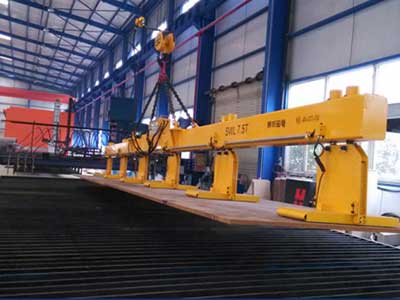
Electromagnetic beam spreader overhead crane for horizontal steel plate handling

Vertical plate clamp with overhead bridge crane for steel plate handling
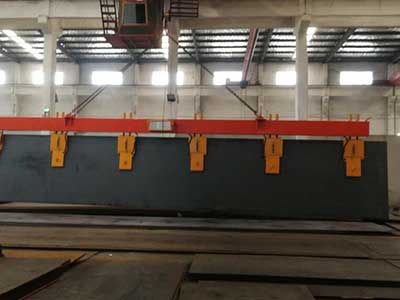
Eot crane with magnetic lifter for horizontal steel plate handling
Cuting edges of lifting magnets
- The magnetic clamping force is equally distributed on the surface of the plate, avoiding scratches or deformations that are frequently caused by plate clamps.
- The heavy metal plate will NOT DROP, causing any injuries or damages - these magnet lifters can keep the heavy plate secured even if there is a power outage.
- This set of vertical lifting magnets can move the plate both vertically and horizontally.
- Magnets can be controlled selectively to raise plates of varied sizes.
- Simple functioning with minimal upkeep.
- Remote control just takes one worker to operate.
Benefits gained by steel manufacturer:
- Steel manufacturers benefited by using magnetic lifting spreader in the following ways:
- higher efficiency and lower labor costs.
- Minimize the number of product defects and the labor intensity.
- Avoid potential safety dangers as effectively as possible.
- Reduce hidden costs while also improving the company's image.
Replacing the mechanical steel plateclampswith a stable magnetic gripping force on the sheet's surface not only solvesall of their problems and worries, but also provides SAFETY, PRODUCTIVITY, and EFFICIENCY to their plate lifting process.
Depending on the dimensions of steel plates in terms of weight, thickness, lengths , the electromagnetic bridge cranes and gantry cranes can be customized to meet your particular application conditions and lifting requirements. Compared with other types of steel plate devices, the magnetic steel plate crane are especially designed for large, long, heavy steel plate handling and in application that require speed, these lifting crane systems really makes difference.They are commonly preferred by businesses like shipyards which often use plates in production.Click more to learn more about the different loads that electromagentic overhead cranes can be used to handle. https://www.eotcranekit.com/overhead-crane/electromagnetic-overhead-crane.html
Your Trusted Overhead Crane Manufacturer & Supplier
How to select Steel Plate Handling Cranes
Custom Steel Plate Crane & Lifter for Your Setup & Needs
There are many various varieties of lifting magnets for steel plate on the market, making it difficult for steel makers to choose the correct one. Knowing how to select a good lifting device/equipment is quite beneficial. As a competent cranemanufacturer and electromagnetic lifter supplier,we are willing to offer some advice from an objective standpoint.
On the market today, there are numerous types of lifting equipment/devices for steel plate. Wire rope, hook, steel plate clamp, vacuum suction cup, permanent magnet, electromagnet, electro permanent magnetic lifter, and other similar items are examples. How to select and what affect your steel plate crane and lifting devices selection?
What Will Affect Steel Plate Crane Selection?
Generally speaking, the following factors will affect the selection of steel handling crane and lifting devices such as, Steel plate material and its flatness, steel plates size specification , specific working environment , working conditions and lfiting requirements, etc.
Flastness & material of steel plates
To choose the best lifting equipment for your plate handling, you must first evaluate its material and flatness.
- If the material is magneto conductive, such as carbon steel, an electric permanent magneticlifter is preferred, followed by an electro-permanent, permanent magnetic lifter.
- If the material is aluminum alloy, the primary optionsshould bea vacuum lifter, hooks, and ropes.
- For stainless steel plate, or when the steel plate surface is neat andflat, and the bending is small, then vacuum lifterwill most likely be used. The vacuum steel plate lifterwill take on the steel plate by removing the internal air pressure. Only the flatness of the steel plate is subject to relatively stringent criteria. Another thing to note is the unexpected power outage. If the power goes out, it can only guarantee suction power for 20 minutes; beyond that, there is no suction power.
Specification of the steel plate
Select the appropriate lifting equipment based on the dimension specification of the steel plate. Let's say the workplace needs to raise a various lengthesof steel plates. To transport the steel plates, you can use a telescopic beam magnetic lifter or a multiple steel handlinglifter.
Specific operation environment
Select the appropriate lifter for the steel plate based on the environment in which it will operate. Suppose it is more convenient to connect to electricity indoors; you will have wide selectionoptions. While connecting power outside is difficult, a battery magnetic steel lifter is advised. Contact us to get your customized steel plate handling bridge cranes and gantry cranes.
Lifing requirement & budget
Finally, based on the specific lifting requirement and steel plate handling equipment budget, different manufacturing workshops and factories has different selections on steel plate handling equipment. Traditional steel plate lifters including hooks, steel wire rope, and steel plate hooks are prefered by small scale factories, due to its low frequency steel handling, light steel weight and small plate sizes or because of its cheap purchasing price, etc.
- High-frequency steel plate handling company. For high-frequency material handling factory, the electro-permanent magnetic lifter is a good choice due to its operation, and high efficiency and safety. In addition, permanent magnetic lifters are suitable for workshops and factorys to handle small steel plates with magnetic workpieces;
- Low -frequency steel plate handling factory. The frequency of steel plate lifting is relatively low in various factories. Probably once every few days or several times every day. In such a situation, it is advisable to usewire rope sling, platehook, or a steel plate clamp, etc.They are ideal for short-term material handlingrequirements. These traditional steel plate liftersare fairly economical and veryconvenient to purchase.
Questions helps you to confirm your environment & needs
You may already have an idea of what you want as you look at your lifting equipment alternatives in your facility.However, are you certain it's the product that will do the job best? Finding out what you need now and how your business might change in the future is the first step in exploring steel plate cranes. To do this, think about the following key problems:
What is your working environment ?
Being fully aware of the environment in which your lifting equipment operates will help you to determine factors that will maximize your operation. Examine your warehouse's setting carefully and make the following notes:
- What are the temperatures in your facility throughout the year?
- What are the dimensions of your facilitystructure?
- How and where will the steel plate handlingcrane be used?
- Do you need dust-proof or explosion-proof desginfor your indoorcrane?
- What is the desired speed for your steel plate handling and crane travelling ?
You can choose the material handlingequipment that is the best fit for your facility by assessing your material handlingprocesses and the surrounding conditions.
Evaluate your operations
What type of crane do you need for your current production processes? What might change in your operation that could impact the type of crane you need in the future? Study your operation should go on at every step of your operation.And the following questions may help you to know your operation process thoroughly?
- Which parts of the crane move the most during your process—the bridge, trolley, or hoist?
- What weight will be lifted?
- How far can the material be lifted?
- How far and how long will the material travel?
- How frequently will the crane do these operations each hour?
What are the parameters & information should i provided to get custom steel plate crane?
In order to give you suitable steel plate crane solution and specific crane price promptly, please help our overhead crane engineer to confirm the following information as much as possible:
- Types of steel plate crane: (Single or double girder? Bridge crane or gantry crane)
- Capacity:
- Span:
- Height of Lift:
- Power supply: (3phase? Voltage? Hz?)
- Bay/ Travelling Length:
- Quantity:
- Operation: Through Pendant/Radio Remote/Cabin Control
- Indoor/Outdoor:
- Application (What are you planning to lift) :
- Environment (Normal/ hazardous) :
- Building drawing if possible:
- Location:
- Industry type: (Eg: steel manufacturing, machinery manufacturing, construction, ship building, automotive, etc. )
- Rail Existing/New: (Size in case of Existing)
- Number of Cranes in bay:
- Existing Structure/New Structure:
- And other special requirements.
What are the information of steel plates required
Steel plates information to confirm :
- Application: (plate cutting, loading and unloading, stockpiling, laser cutting, etc.),
- Minimum and maximum sizes of plates,
- Minimum and maximum thickness plates,
- Number of plates to be lifted at once,
What types of steel plate lifter prefered:
- Wire rope slings
- Steel plate hook
- Steel plate clamps,
- Vacuum lifters
- Magnetic lifters
- or others.
- Customized steel plate lifters are available.
If you do not know about how to select the plate handling crane, please feel free to leave us a message or email today and the reply of our crane engineer will be given within 24 hours. Get your custom design plate handling crane. Contact us today to get your customized steel plate crane and plate lifter.
Custom steel plate handling crane projects for your reference

10 ton overhead bridge cranes are equipped with magnetic lifters for thick plates handling with the steel specifications of Length: 4.7-12m, Width: 1.5-2.5m, Thickness: 6-50mm, etc.

16 Ton Steel Plate Lifting Magnet for Outdoor Plate Stacking
The l6 ton overhead goliath crane,with magnetic steel plate lifters can be used to operate steel plates stacking and destacking. It can pick up a single steel plate weighing up to 15 tons, 15 meters in length, without clinging to the next sheet.
Your Trusted Overhead Crane Manufacturer & Supplier
Hazards & Safety Requirements for
Steel Plates Lifting, Transporting & Storage
For meet steel plate handling in various situation in different industrial sectors. The plate handling crane needs to be customized. If you need a custom steel plate cranes, please feel free to contact us to get free consultation on steel plates handling. Steel plate, which is utilized in the construction of vessels and machinery, poses challenges in terms of safe handling and storage at fabricators' operations and warehouses.
Hazards
- The primary risk while handling steel plates is dropping the weight due to faulty lifting attachments, overloaded machinery, or unbalanced loads. Personnel could also be struck by cables, chains, or hooks that are in motion.
- Hazards related to lifting devices include handling them, coming into contact with sharp edges of plates, losing control of large objects while they are being raised and moved, getting shocked by powered hoists or lifting electromagnets, etc.
Crane safety requirements
Every liftingcrane must have a plate or tag that clearly displays the safe load limit so that rigging staff on the ground can see it. The rigging staff and crane operators should have quick access to charts outlining the safe load limitations for both the wire rope slings and alloy steel chain slings that are being utilized. According to OSHA regulations, crane operators need to receive training.
All electric crane and hoist installations must comply with the National Electrical Code. Only licensed people should work on electrical systems. Use only enclosed runway conductors if possible.
Crane parts that are subject to impact, wear, and hard handling should have a five-to-one safety factor. (The amount of times the breaking strength exceeds the acceptable load limit is a safety factor.)
- The load hook;
- Hoisting cables, gears, and other wearable parts;
- All other parts, including structural steel;
- The frequency of inspections of the crane and its equipment, as well as record-keeping, must meet OSHA (and state, if applicable) regulations.
Steel Plate handling Hazards & Crane Safety
On steel plates lifting and transporting
Personnel involved in steel plate transportation must be well trained. They should be aware of and educated on the risks associated.
Hazards on steel plates lifting and transportation
These hazards on lifting and transportation of steel plates include:Attaching lifting devices to plates; Swinging hooks; Chains and cables.
Safety requirements on steel plates lifting and transportation
- Before performing lifts, center crane hooks over the payload. Place lifting devices so that (a) weights are balanced and (b) lifting attachment damage to the plate is minimized.
- Before and during a lift, personnel must be warned to stay out from under the weight using sirens, bells, horns, and other auditory signals as well as flashing lights. Never should loads be carried over employees.
- To direct riggers and crane operators, signalmen may only utilize conventional signals.It is forbidden to use improvised signals.
- When lifting loads, crane operators must exercise tremendous caution; they must never rely on limit switches to stop loads. Limit switches must be kept in excellent working order and tested at the beginning of each shift. The overhead or gantrycrane should be taken out of service right away if a switch stops working, and it shouldn't be used again until the necessary repairs have been done.
- When moving plates on automobiles or dollies, the personnel moving the cargo are required to use a horn or another audible signal. If using auditory signal devices is not an option, place a signalman in front of the moving car or dolly.
On steel plates handling in storage yards & storage area
Storage yards
Provide a minimum of 4 feet of clearance on either side of the railroad tracks in the material storage yard to allow for suitable working space. Additionally, provide at least 30 inches between the ground and the outside rails of an opening buggy track. Installing "close clearance" signage is required if the 30 inch clearance cannot be kept.
All truck access lanes must be at least 11 feet wide. When it is feasible, create paths that are at least 30 inches wide so that people may access the forward (marked) ends of piled items.
Storage areas
Make sure storage areas are clear of obstacles, well-compacted or paved, and level. Non-permanent skids must be strong enough to handle the highest projected loads when in operation. During weather conditions that include either heavy rain or freezing and thawing (when ground heave or settlement may occur), check the stability of the support skids.
Timber blocking and cribbing
For receiving or shipping yard blocking, use strong lumber. Three by four inches, four by four inches, four by six inches, and six by eight inches are recommended sizes, with lengths as needed.
Blocks are typically positioned directly above points of skid support. Place rectangular-shaped steel-supporting blocks with their long dimensions horizontal. Blocking should not be extended beyond the steel piles so that it interferes with nearby lifts.
Piling steel plate
It is critical to make appropriate use of yard storage in piling material in order to achieve both the highest output (in tons per square foot) and the most efficient handling to and from the shop. This is best accomplished by building sturdy single piles.
For safe handling, make sure the widths and lengths of the plates in each lift are roughly the same. Before lifting, it is advised to reduce the width and length of the plates from the bottom to the top of the pile, as in a pyramidal configuration, to ensure pile stability. When plates are close to pathways, vertically align the head (marked) end of the plates. To reveal identification markers, the plate can be stepped or offset endwise (Figure 2).

There are several safe ways to stack steel plates that range in width from 6 to 30 inches (as left pic). Usually, bands or wires are used to bundle plates up to 12 inches wide for delivery. Banded or wired bundles should never be lifted or pulled by the strap or wire. Unless they need to be broken to sort for handling, they should stay this way.When cutting steel banding, take the appropriate safety precautions.
Flat plates can be stacked in a number of different ways, as shown in Figure 1: A (solid), B (multiple), C (blocked and tiered), D (single tiered), and E (single blocked).

A skid spacing of 7 to 10 feet is usually sufficient to sustain plates without significant sagging. Plates should be supported from the ground or pavement by cribbed blocks when they are not supported by the skids and extend past the end of a pile (as left image). Figure 2 shows how to stack plates in an offset or "step" manner to disclose identification marks. Take note of the cribbed blocks used to hold two plates with a sizable overhang.
This is required when the plate overhangs more than 25% of its length and exceeds the amount in following list .
Plate thickness : allowable overhead hangs :1/4 to 1/2 inches : 6 feet ,More than 1/2 to 3/3 inches : 9 feet ,More than 3/4 to 1 inch : 12 feet ,More than 1 inche : 15 feet ,
Set the cribbed blocks on end to hold overhanging plates from the ground or plates beneath.

Plates wider than 30 inches can be used to build sturdy heaps of any convenient height. If the pile is firm, subsequent lifts can be staggered laterally to help with handling (as left drawing ).
Figure 3: Each lift of a solid pile can be staggered laterally for plates wider than 30 inches.

When there are width variances and plates are handled with hooks, place the broadest plate at the bottom of the lift. Extend the margins of this plate beyond the edges of the plates above it (as left picture). If lifting magnets or vacuum pods are utilized, plates can be stacked solidly without the necessity of spacers. If lifting clamps are utilized, insert wood strips or blocks between plates to allow for simple clamp entry.
Figure 4: If the plate widths vary, the bottom plate of each lift should be the widest.

Pile plates and slabs that are too short to safely span skids on temporary timber should be tiered with timber blocks between each plate or lift of plates. Plate inventory can be held on the edge in racks, as indicated in left picture.
Figure 5. Racks for stacking plates on edge.
Housekeeping and inspection
Good housekeeping and craneinspection practices will significantly help in the prevention of accidents. Good housekeeping is especially critical on crane runways, in crane cabs, and in storage facilities. Regularly inspect every place of work to ensure that acceptable housekeeping procedures are being followed.
According to Federal OSHA or state laws, all equipment must be examined on a regular basis. Defective equipment must be decommissioned and properly labeled out. Ensure that all federal and state record-keeping standards are met.
Hammers, steel wedges, pry bars, and other hand tools must be kept in good working order. Hammers with fractured handles or loose heads must be fixed right away or marked "out of service."At regular intervals, inspect steel wedges for mushroomed heads and dull or chipped tips. Remove moderately bent pry bars from service.
Personal protective equipment
- Because unloading and transporting steel plate involves a lot of overhead work, protective hats must always be worn.
- Additionally, foot protection is required. It is advised to wear safety shoes with metatarsal protection.
- Protective equipment for the legs and skins may also be necessary.
- Use hand protection, such as leather gloves or arm guard hand leathers, to protect your hands from the steel plates' burrs, sharp edges, and other potential risks. Metal reinforcements may be used in these gloves.
- Wearing eye protection is a requirement in general. Coverall goggles can aid in preventing eye damage brought on by scale and dust carried by the wind in storage locations. Wearing safety glasses with side shields or goggles with a shade-two filter lens will protect you from stray flashes and reflected radiation if welding is going to be done nearby. Shield welding processes when possible.
- Other specialized pieces of protective clothing can be required depending on the dangers caused by neighboring operations. For instance, hearing protection must be worn if the noise level is too loud and cannot be adjusted.
Main Projects
Related Products
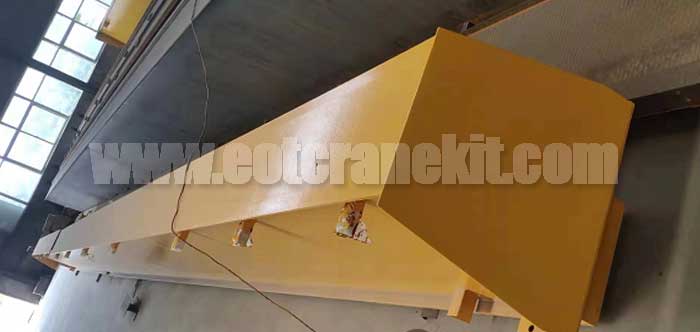
6.3 ton overhead crane kit for sale Philippines, complete single girder top running overhead crane system, low headroom design for workshop indoor use.
Free consultation to Confirm Parameters & Specifications and Get
Latest Crane Price & Crane Rate.
- Types of overhead cranes : _______?
- Optional: Overhead travelling crane, goliath gantry crane,Slewing jib crane, Single girder or double girder crane,small portable crane or kbk crane, etc.
- Capacity of overhead crane: _______?
- Optional: 0.25ton, 0.5 ton, 1 ton, 2 ton, 3ton, 5 ton, 10 ton,15ton, 20ton, 25 ton, 30ton,35ton, up to 550ton, etc.
- Crane span & lifting height : _______?
- Crane travelling length : _____?
- Control of overhead crane:_______?
- Optional: pendant/ remote/cabin control
- Voltage supply of overhead crane:_____?
- Eg,: 380V50/60HZ,3Phase or others,etc.
- Application/usage of crane:_______?
- Eg,: Steel mill, ,injection mold, cement,stone, concrete,granite, general manufacturing, etc.
Just leave a message via the contact form and our hoist and crane engineer will contact you with in 24working hours.
Get In Touch
